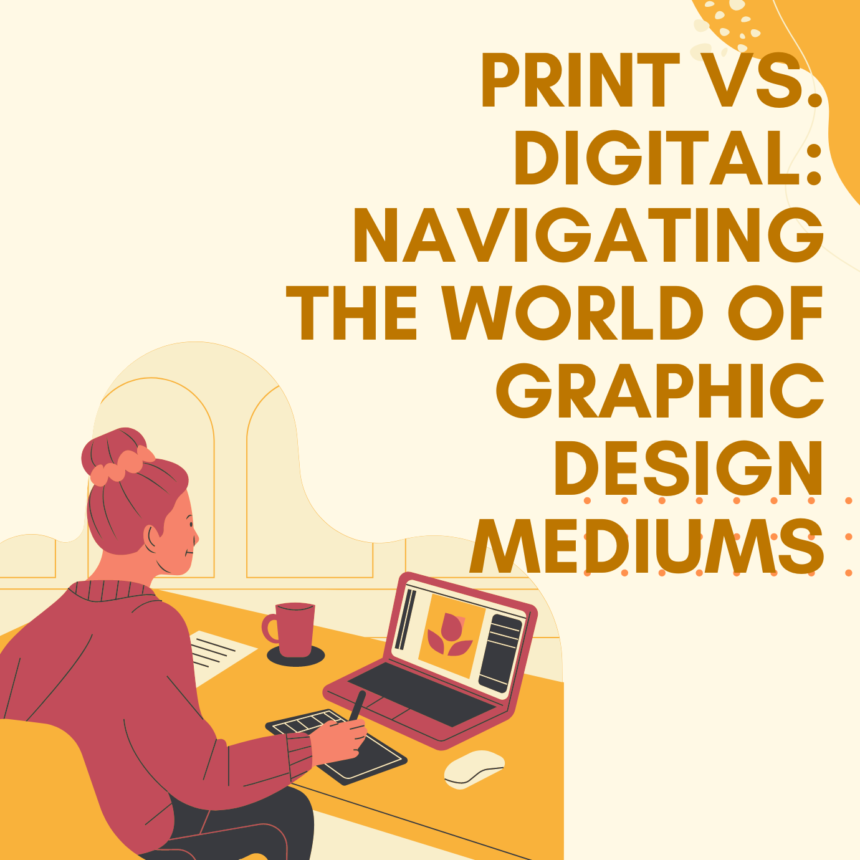Graphic design encompasses various mediums, each with its unique characteristics and considerations. Print and digital design are two prominent mediums that require different approaches and considerations. Here’s a closer look at the differences and considerations when navigating the world of print and digital graphic design:
Print Design:
1. Tangible and Physical:
Print design involves creating visuals for physical mediums such as brochures, posters, packaging, magazines, or newspapers. The tangible nature of print design allows for tactile experiences, such as feeling the texture of paper or interacting with physical materials.
2. Fixed Layouts and Sizes:
Print designs have fixed layouts and sizes, determined by the dimensions of the printed medium. Designers must consider factors like bleed, trim lines, and margins to ensure that the final printed product appears as intended. Attention to detail is crucial to avoid any issues during the printing process.
3. Color Considerations:
Print designs require careful consideration of color modes and printing techniques. Designers typically work with CMYK color mode to ensure accurate color reproduction on printed materials. They also need to be mindful of color variations that may occur due to different printing processes or paper types.
4. Typography and Fonts:
In print design, designers have more flexibility in choosing fonts and typographic elements. They can utilize a wide range of typefaces, including those with intricate details or decorative characteristics. However, it’s essential to ensure legibility and readability, especially for smaller text sizes.
5. Precise Image Resolution:
Print design requires high-resolution images to maintain visual quality when printed. Designers need to work with images at a suitable resolution (usually 300 DPI or higher) to ensure crisp and clear prints. Scaling up low-resolution images can result in pixelation and a loss of image quality.
Digital Design:
1. Interactive and Dynamic:
Digital design involves creating visuals for screens, websites, mobile apps, social media, or multimedia presentations. It allows for interactivity, animations, and dynamic elements that engage users and enhance the user experience.
2. Responsive and Adaptive Layouts:
Digital designs need to be responsive and adaptable to different screen sizes and devices. Designers must consider various screen resolutions, aspect ratios, and orientations to ensure optimal viewing experiences across devices.
3. RGB Color Mode:
Digital designs typically use the RGB color mode to display colors on screens accurately. Designers have more flexibility in working with vibrant and saturated colors to create visually appealing digital experiences. However, they should also consider color consistency across different devices and screens.
4. Web Typography and Font Licensing:
Digital design requires careful selection of web-safe fonts to ensure consistent typography across different platforms and devices. Designers need to consider font licensing for web usage and explore options like web fonts or fallback fonts to ensure legibility and visual consistency.
5. Optimized Image Formats:
Digital design involves optimizing images for web or screen display. Designers need to consider file formats like JPEG, PNG, or SVG and strike a balance between image quality and file size to ensure fast loading times and optimal performance.
Considerations and Convergence:
While print and digital design have distinct characteristics, there is an increasing convergence between the two mediums. Designers often need to consider how their designs will be used across both print and digital platforms. Consistency in brand identity, typography, and visual elements is vital to maintain a cohesive brand experience across different mediums.
The choice between print and digital mediums depends on the specific project requirements, target audience, budget, and desired outcomes. Some projects may be more suited for print, such as physical marketing materials or product packaging, while others may require a digital presence, like websites or social media graphics.
As the design landscape evolves, designers need to be versatile in both print and digital mediums, understanding the unique considerations and tailoring their designs to deliver effective visual experiences, whether in print or on-screen.
